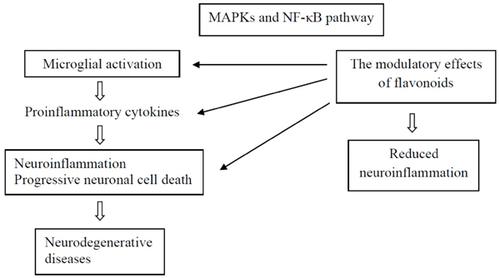Mini-Reviews in Medicinal Chemistry ( IF 3.8 ) Pub Date : 2020-08-31 , DOI: 10.2174/1389557519666190617150051 Zehra Calis 1 , Rasim Mogulkoc 1 , Abdülkerim Kasim Baltaci 1

|
The inflammatory process in the human body is a physiological response involving many cellular types and mediators. It results in scar formation to separate the damaged area from the surrounding healthy tissue. Because of increased blood-brain barrier permeability following inflammation, leukocytes infiltrate the CNS and are also supplemented by proinflammatory mediators. However, an acute inflammatory process after cerebral trauma or stroke may also result in a prolonged lesion formation, leading to a severe neuronal loss. The prolonged inflammatory process in the CNS may cause serious damage to the neuronal system. It may lead to CNS damage in such a way that endangers functional integration and proinflammatory system balance. Effects of different flavonoid species on ischemia-reperfusion injury and cognition and function have also been shown in experimental studies. Flavonoids are presented broadly in plants and diets. They are believed to have various bioactive effects including anti-viral, anti-inflammatory, cardioprotective, anti-diabetic, anti-cancer, anti-aging, etc. Quercetine is the predominant dietary flavonoid. Main sources are tea, onion, and apple. It is demonstrated that the frequently consumed food like soybean, peanut, mustard, rice, sesame, olive, potatoes, onion, and oats contain flavonoids. Catechin and its derivates which are isolated from tea leaves have antioxidant activity but in low doses, their prooxidant effects are also reported. Ipriflavone which is a synthetic flavonoid may increase total calcium in bone. In this review, the effects of flavonoids species on the inflammatory process in the neurodegenerative process were examined as general.
中文翻译:

类黄酮/类黄酮在神经变性和神经炎症中的作用。
人体的炎症过程是一种生理反应,涉及许多细胞类型和介体。它导致疤痕形成,将受损区域与周围的健康组织分开。由于炎症后血脑屏障的通透性增加,白细胞会渗入CNS,并由促炎介质补充。但是,脑外伤或中风后的急性炎症过程也可能导致病变形成时间延长,从而导致严重的神经元丢失。中枢神经系统的炎症过程延长可能会严重损害神经系统。它可能以危害功能整合和促炎系统平衡的方式导致中枢神经系统损害。实验研究也显示了不同的类黄酮对缺血再灌注损伤以及认知和功能的影响。类黄酮广泛存在于植物和饮食中。据信它们具有多种生物活性作用,包括抗病毒,抗炎,保护心脏,抗糖尿病,抗癌,抗衰老等。槲皮素是主要的饮食类黄酮。主要来源是茶,洋葱和苹果。事实证明,经常食用的食物,如大豆,花生,芥末,大米,芝麻,橄榄,土豆,洋葱和燕麦中含有类黄酮。从茶叶中分离出的儿茶素及其衍生物具有抗氧化活性,但在低剂量时也有其抗氧化作用。异黄酮是合成类黄酮,可能会增加骨骼中的总钙。在这篇评论中



























 京公网安备 11010802027423号
京公网安备 11010802027423号